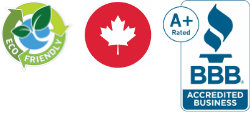
How Does a Septic System Work?
Your septic system design includes many parts, such as the septic tank, baffles, and effluent filter, septic pump chamber, holding tank, and leaching bed. Your system may also have a biofiltration system or an aeration treatment plant.
These septic system parts work together to process the harmful waste and water from your home or business, and return it to the environment as filtered wastewater.
Septic System Parts
Septic Tank
Typically, your residential septic tank will be approximately 5 feet wide, 8 feet long, and 5 feet deep, made from concrete, and have a capacity of about 750 to 2000 gallons. Many newer models are comprised of two compartments featuring an inlet and outlet baffle, as well as an effluent filter. Septic tanks today can be plastic or concrete. Plastic is preferred when a crane truck cannot gain access into a construction site. The preferred tank for most situations where a tank replacement is necessary would be a plastic tank.
Septic Tank Baffles
The baffles on a septic tank are installed at the inlets and outlets. The inlet baffle prevents mixing in a portioned septic tank, and the outlet baffle keeps suspended solids from moving to the leaching field. Both baffles are essential in keeping the surface scum layer undisturbed.
Baffles are typically made from plastic, but in older systems, they were made from concrete. No matter what kind of baffles you have, it is always important to have them inspected along with the tank itself.
Effluent Filter
Along with the outlet baffle, an effluent filter keeps suspended solids from exiting into the leaching field or tile bed. If the filter and the baffle are not working correctly, they can cause backups and tile bed failure. Effluent filters are a good way to increase the life of your system and insure its proper function.
Effluent filters are mandatory in all new systems, and maintenance is required throughout the year to keep them in top shape. If you have an older septic tank and would like an effluent filter installed, contact us.
Manufacturers advise cleaning the effluent filter at least once every six months. You can schedule this service with us, or, if you are up to the challenge, we can provide you with training to perform this service yourself.
Septic Pump Chamber
For larger septic systems that require a raised leaching bed, a septic pump is often required to move the effluent to the leaching field. Our trained technicians can install and maintain your septic pump as needed. Besides supplying new pumps, we can also install an alarm system which warns you if your septic pump is not working properly.
It is very important to have a pump chamber inspected every two to three years and pumped out if necessary. You do not want any sludge building up in this tank as it will harm the pump and will cause damage if pumped to the leaching bed.
Septic Holding Tanks
With some properties, storage tanks, called holding tanks, are used instead of drainage fields. These tanks typically hold 2000 gallons of wastewater or more. As the tank fills up, an alarm warns you when it is time to have it pumped.
Leaching Beds/Tile Fields
Various distribution systems exist for the wastewater that exits the septic tank. Some of the common layouts include conventional leaching beds, raised leaching beds, area beds, filter beds, Types 1 & 2 dispersal beds, and shallow buried trenches.
The type of system required is dependent on a number of factors, including the location of the septic system, the size of the system needed, soil conditions, etc. Weber Environmental Services can design a distribution system that is the best option for your needs and your budget.
Biofiltration Systems
A biofiltration system typically takes up less space than a traditional septic tank, and operates differently than a septic tank system. When wastewater enters a biofiltration system, it is dispersed over the surface of a filter media bed. That filtration system removes much of the harmful organic waste before the discharge is released into the ground.
When considering this option, you must follow local regulatory standards about site location. You should also consider the usage required of this system. To learn more, please contact us.
Sewage Treatment Plants
Some residential and commercial septic systems have a component called a sewage treatment plant. This component is installed to help clean the outflowing wastewater. Each sewage treatment plant is required to have annual maintenance and constant monitoring. Weber Environmental Services can serve as your regular maintenance provider, and we will ensure that all necessary regulations are being met. If you have any questions, or if you think this is a viable option for you, please contact us.
Water Usage and Your Septic System
When you have a septic system, all water coming from the house or business passes through it. From the toilets, showers, and tap water to the dishwasher or washing machine, your septic system processes all water usage.
Although your septic system was designed with maximum usage in mind, remember that if all of these appliances are running at the same time, your septic system must process a huge influx of water all at once. This much water at one time may cause stress to your septic system, which may slow down, or dilute the available bacteria in your septic tank. Spacing out the water usage to allow your septic system to keep up will help your system work more effectively and efficiently. You may also want to conserve water through high-efficiency toilets and showerheads, and check regularly for leaky faucets or other water loss.
What Does Not Belong in my Septic System
To keep your septic system running well for as long as possible, there are certain rules to follow about what you flush, drain, or otherwise enters your septic system. Here are some examples of things that you should avoid:
- Disinfectants or bleaches (use sparingly, and look for biodegradable/non-toxic brands).
- Detergents (only use biodegradable, low-suds and phosphate free detergent).
- Heavy paper products like paper towels are slow to break down and if too many are used they will plug the tank.
- Wipes/Baby wipes are usually covered in anti-bacterial agents, which kill the naturally growing bacteria in the septic tank which are essential to a well-functioning septic system. They also do not break down, and can clog the system.
- Natural bacteria will not break down coloured paper, and non-bleached papers are slow to break down.
- Oils, grease, latex paint and discharge from water softeners.
- Chemical wastes such as solvents, paint thinners, caustic cleaners, pesticides, herbicides.
- Non-organic objects
- Automotive fluids
- Bandages
- Cigarette butts
- Coffee grounds
- Cooking grease
- Cotton balls
- Disposable baby diapers
- Food wastes
- Hair
- Kitty litter
- Mud
- Paper towels
- Plastic products
- Rags
- Sanitary napkins, and female personal hygiene products
- Strings
- Swiffer® pads
519-648-2510
Kitchener
Waterloo
Breslau
Maryhill
Bridgeport
Bloomingdale
519-622-9230
Cambridge
Ayr
Roseville
Branchton
519-634-8764
Mannheim
New Dundee
New Hamburg
Petersburg
Baden
519-664-1041
St. Jacobs
Elmira
Conestogo
Heidelberg
St. Clements
Linwood
Hawkesville
519-763-4170
Guelph
Elora
Fergus
Ariss
Acton
Hillsburgh
Rockwood





